The School Car Pickup Line Is a National Embarrassment
Your grandpa probably really did walk 5 miles to school in a foot of snow. A look at the changing numbers for how American students get to school.
I teach a lot of international students about the US education system and our schools. Whenever they go into our schools for the first time, one of the things that always shocks them is the school car pickup traffic lines. These lines are ugly, annoying, dirty, and they have become a common mainstay in American schooling.
Parents across the country must waste much of their mornings and afternoons in these lines. These lines are so pervasive that an entire subculture has sprung up around them. Mommy bloggers even swap book suggestions to help pass the time.
Parents often hate having to sit in these lines, and it is even absurd that we expect them to do so. The school car pickup line is a national embarrassment. It wasn’t always like this, and it doesn’t have to be this way.
Getting to School by the Numbers
The classic yellow school bus is a national icon. It was on these buses that a lot of us used to take to school, with its own little culture worth a future article. But the numbers show that taking the school bus to school is not as common as before.
In fact, in 2022 only about 28% of US students used the school bus to get to school.1 Using the school bus is trending down, as shown in Chart I. In 1969, about 38% of students used the bus, similar to 2009 with 37.5%, and further dropping in 2017 to 36.5%.
Further looking at the comparisons between the years yields even starker divides. In the 1960s, over 40% of students in the US walked or biked to school. While the data for the 1970s to the 1990s are unavailable, there was obviously a massive drop over the decades into the 2000s. Now, just under 11% of students walk or bike to school.
The differences in how students have gotten to school come in the form of private cars (including trucks or minivans). Having a private vehicle was fairly rare in 1969, with only about 16% of students. It exploded to just under half by 2009, and has continued to climb to over 56% of students taken to school. Being driven to school in a private vehicle is only trending upwards, meaning school car pickup lines will only become a more entrenched problem.
Sadly, public transportation has never been a significant factor nationally for getting kids to school. Just 3% of students used public transit in the 1960s, which was similar to today.
Schools on the Edge of Town
Parents are not simply choosing to drive their children to school because it’s fun to sit in a long line. It is becoming more of a necessity because schools are more spread out than before, or at least families are living further from their schools.
In 1969, over a third of US students lived within one mile of their school, with about the same percentage living three miles or more, as shown on Chat II. Obviously, if students live closer to school, it’s easier to walk, bike, or take the school bus.
Looking at the more recent years, the distance between schools has rapidly risen. In both 2009 and 2017, over 82% of kids lived more than three miles from their school. Living that far from school means that it is not feasible to walk, and that’s fairly far for a youngster to bike. Likewise, with the sprawl, the school bus takes a lot longer. The only option becomes for one parent to drop off kids.
This issue is related to cost-saving budgeting in K-12 education. States and districts have looked to save money through school consolidation, often moving them to cheaper land on the edge of towns. This means that rather than several neighborhood schools in a district, there might just be one or a few larger ones, saving on administrative costs. As the boundary lines of attendance stretch further, parents are forced to drive.
Japan Today is Like 1960s America
While I hesitate to rely on other countries as models for the US (I prefer looking at or past for inspiration), these kinds of examples can at least show us things aren’t impossible. Given the takeoff of helicopter parenting in the US, kids have very little independence. It is likely impossible for an American parent to imagine their child walking down to the corner store (if they even exist), let alone going to school across town by themselves.
But these tasks are not impossible for young children. They can do it, they can do it successfully, and they do it every day in Japan. The little girl in the video below is an example. She walks down to the metro station and takes the subway to her school without parental involvement.
Most Americans are probably dumbfounded that a child could have such independence and agency. Although, I must admit that the second half of the video centers on Australia, a country that has similar sentiments about getting to school as we do in the US.
Many Americans probably like the idea of what they see in Japan, but they would say that the US is much more unsafe, which is true. Mommy blogs and social media feeds are filled with tales of potential abductions, with warnings for parents to not let little Jane or Johnny out of sight or face kidnapping.
The truth is that the stranger danger panics are overblown. However, it is still true that the US is unsafe, but it is not from hidden kidnappers hiding under cars. Instead, the danger comes from cars themselves.
Cars pose an immense threat to children, the leading cause of death for American youngsters is from car-related incidents. It is rational for parents in the US to forbid their kids to walk anywhere because we’ve made it so dangerous to walk anywhere.
It’s not the kidnappers, nor the distance stopping kids in the US from independently getting to school. It’s the car-centric design of our cities.
It Goes Beyond Parental Choice
My own hometown, I lived roughly 2 miles from my elementary school. It never occurred to us that I may walk or bike to school. Look below at the Google Map view of the street that I would have had to navigate on my way to school. No sidewalks, no bike lanes, nothing for anyone outside of a car. It would be ludicrous to let kids walk to school here, so I rode the school bus.
You can see this from the data presented in Table I. In 1969, for those who lived 1 to 1.9 miles from school, almost half still walked. Juxtaposed that to 2017, the last year the data was available, and at those same distances only 7% of those students walked or biked. In 2017, private cars accounted for over 55% of school trips at just .5 miles away from the destination. It likely has only gotten worse.
The budget cuts mentioned above that impact consolidation also affect transport services. Districts have been cutting buses, partly because they don’t have enough drivers, or simply because the service is too costly. The service cuts are often for those students who live within what is considered a walkable distance.
Unfortunately, just because a student lives with a mile of the school doesn’t mean the walk or bike is safe. There are massive gaps throughout the country in terms of pedestrian safety measures. Rather than risking their child’s life, and without an option of bus service, parents choose to drive their kids if they have the ability.
It’s not that the roads in 1960s America were some bastion of Amsterdam-like safety. Instead, there simply was a growing awareness of how dangerous American streets were for kids. Rather than trying to make our spaces better, we collectively decided that kids should never be trusted to do anything ever again.
In fact, the number of youth fatalities due to cars has dropped precipitously over the last few reasons precisely because we no longer allow kids to walk, bike, or simply roam like they used to. Hence, we see the rise in helicopter parenting culture in the US.
What Can Parents and Communities Do?
The school car pickup traffic problem is not something that parents can fix alone. It is going to take an entire community banding together to change the physical environment and cultural expectations.
First, parents need to recognize that there is a problem in the first place. Chauffering kids to and from school in long traffic lines is an absurd practice. As Lenore Skenazy, founder of the Free Range Movement and Let Grow, says of kids, “They are humans! They deserve some independence.”
It’s not just a message to parents, it’s the broader society. Some schools have even banned students from commuting by bike. Likewise, a mom was recently arrested for letting her 10-year-old son walk into town. These types of incidents only fuel the school car pickup culture
One of the real innovations regarding this issue that has arisen in recent years is the e-bike. E-bikes give kids a lot more agency to actually get around in our sprawled-out cities. In my own town, I see students biking all over, including to the local schools.
Unfortunately, the rise of e-bikes has led to some externalities. They are indeed fast, and kids, especially young boys, can do stupid things on them. I regularly see kids swerving across dark 50-MPH streets at night without lights. We cannot simply ban e-bikes, we must embrace them and enmesh them into the broader transportation network.
Right now, bikes, whether regular or electric, are simply afterthoughts in most communities. Since we don’t have bike lanes, I notice kids always ride on the sidewalks—a rational choice. Our communities must build better biking infrastructure, like real protected bike lanes, to properly grapple with the new technology.
Even without the bike lanes, communities can consider organizing a Bike Bus. This is where a large pack of students all bike together creating a large mass on the road to help with safety, visibility, and confidence. A Bike Bus can help build community, too.
However, I would not feel comfortable doing a Bike Bus everywhere. For instance, back in my hometown, I could easily imagine a driver doing 60 MPH, TikToking, flying over a hill, and plowing into the group. It definitely varies by the space and locality.
In the end, fixing our school car pickup line culture is going to need redevelopment of our towns and cities. We need to thicken up our places, slow down cars, and install pedestrian or biking infrastructure. It won’t happen overnight. But if we want to give back some time to parents and more independence to kids, American streets are the thing that must change.
This data comes from NHTS. Every few years they collect this kind of travel and transportation data, but it is a bit of a mess and doesn’t stay consistent. Apparently, in the most recent survey from 2022 released in 2024, they removed the distance to school question: “some questions were removed to obtain more details on how households were responding to changes in work and school locations and availability of more online transactions.”
Instead, they added in some COVID digital school questions which I recognized probably seemed important in the moment but are not that useful for longitudinal comparison. This is disappointing because it is key for us to use this indicator to critique. Data for some years is also not available. The article covers what is accessible.





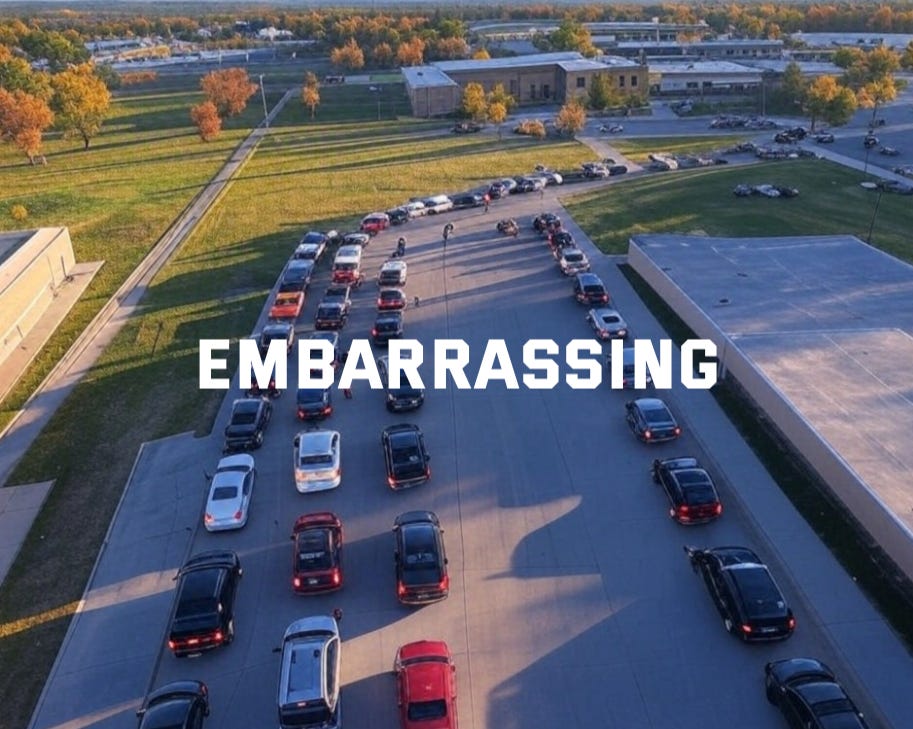
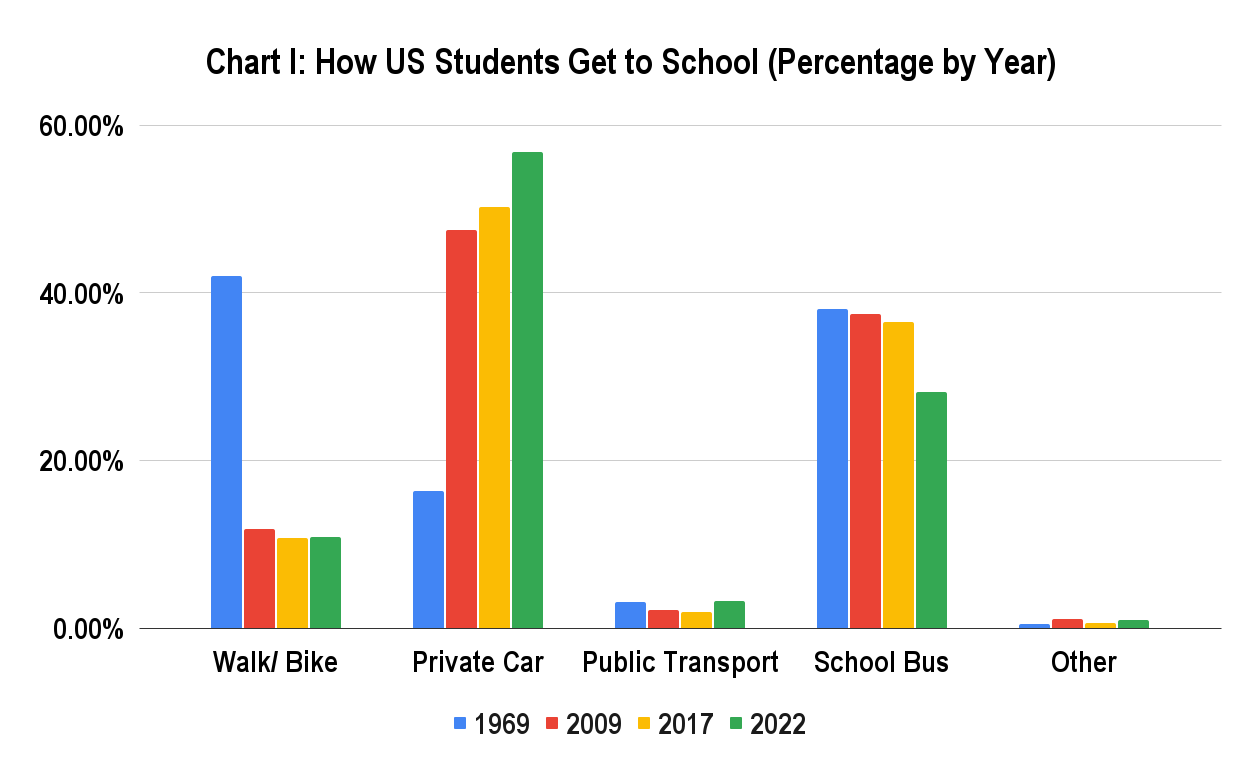
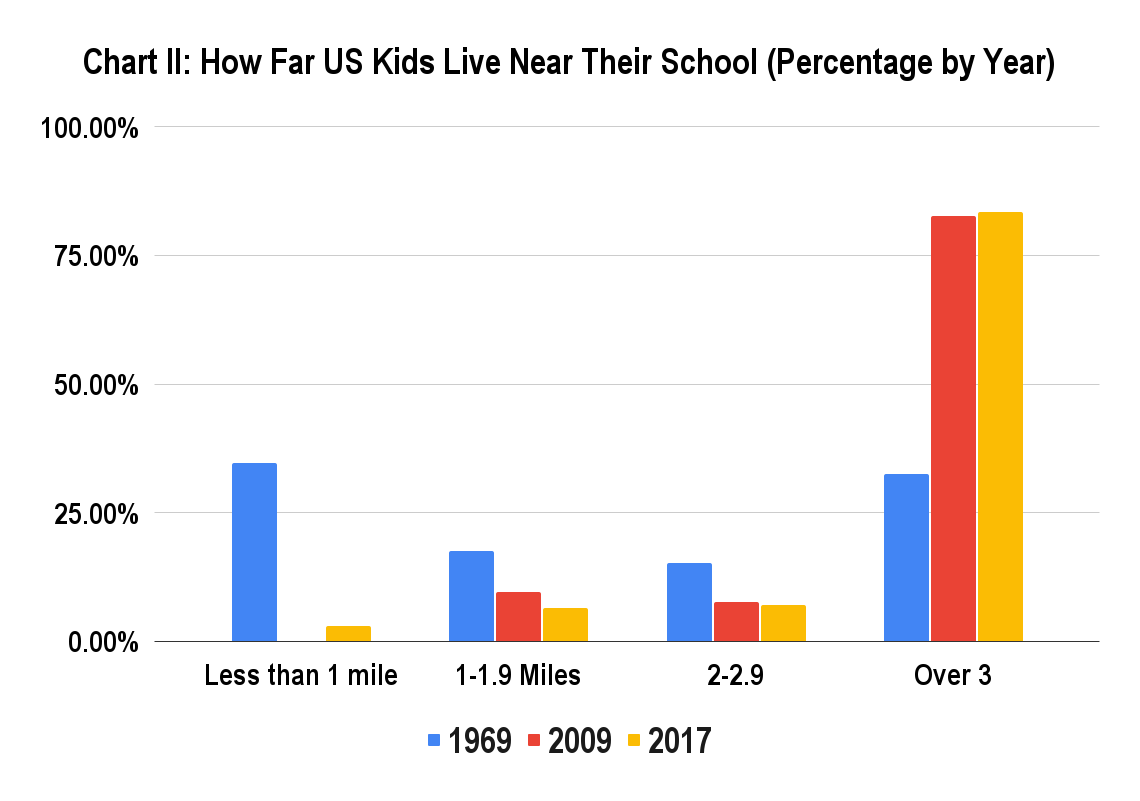

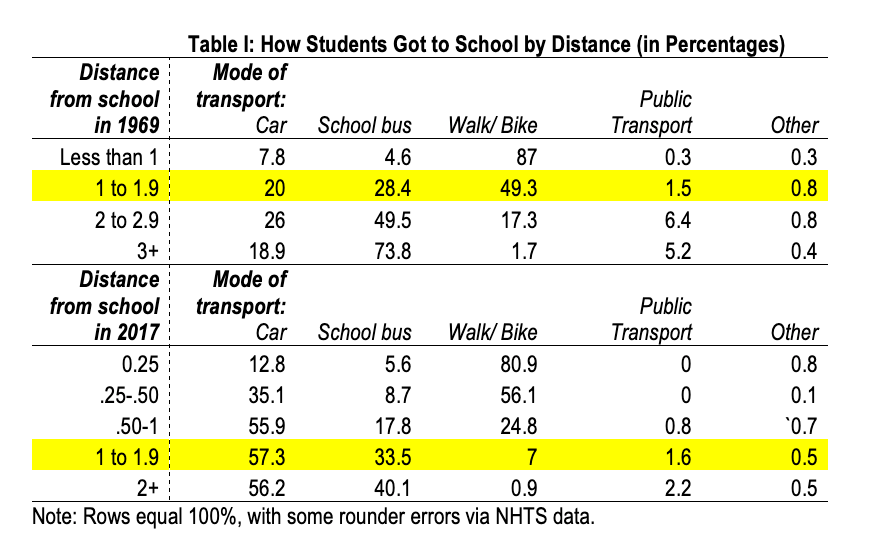
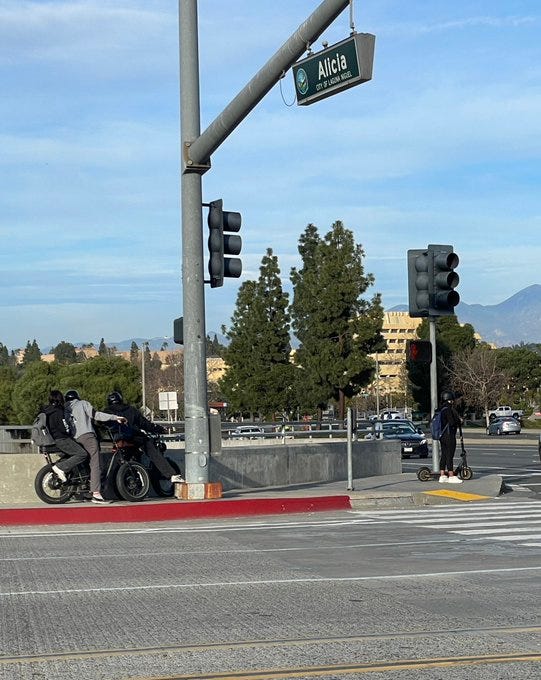
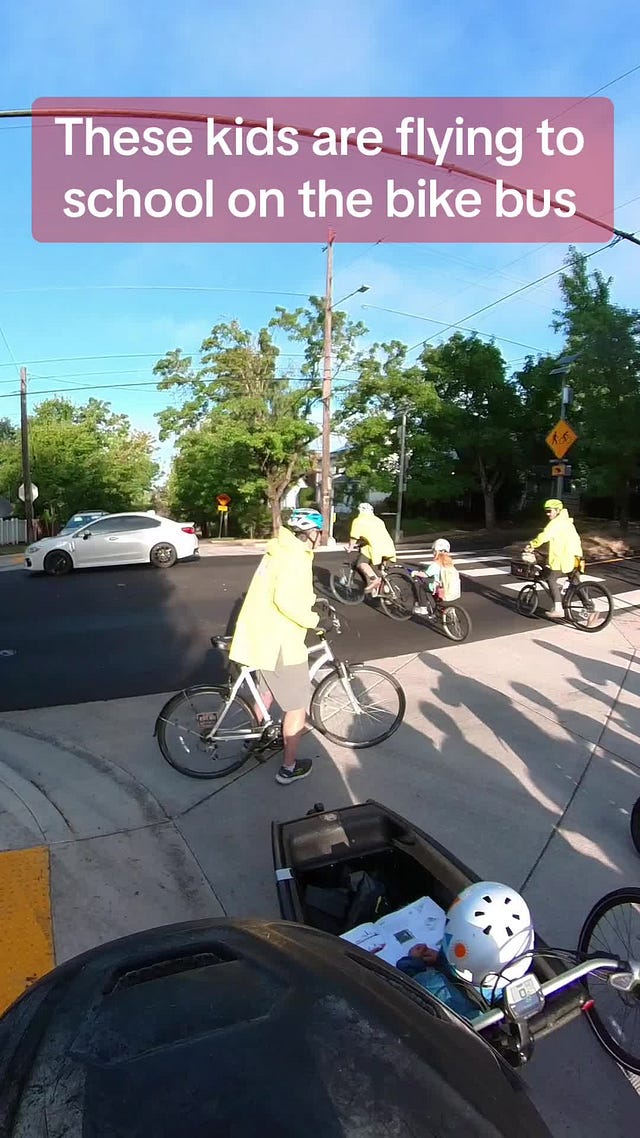

I worked in schools for almost 10 years before having my children. Unfortunately schools are no longer considered safe spaces for many children in America. My children prefer for me to drop them off at school because they feel safer than being on the bus. Dropping my children off at school also means they aren’t being exposed to inappropriate things by older students with cell phones. We could all sit here and say “when I was a kid” but this is 2025, we didn’t grow up in this current reality. Once we get some gun control, and harsher punishment for pedophiles then maybe us parents would have the mental space to handle the car line problem.
1) I got kicked off the bus for graffiti in 5th grade. Got to ride my bike 2 miles to school.
2) I live in a rural suburb now. No sidewalks. The school is 25 lots away and completely un-walkable or bikable. Dear doge: please return funds to municipalities